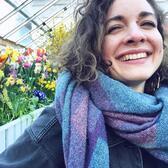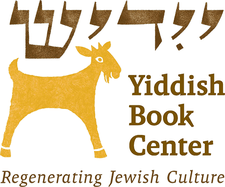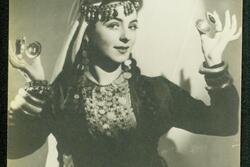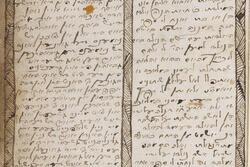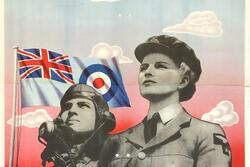From the Archive: A Page from Beyle Schaechter-Gottesman’s Book "Mir Forn"
Page from Beyle Schaechter-Gottesman’s children’s book, Mir Forn, collected as an artifact associated with her Oral History Interview, conducted by Christa Whitney for the Yiddish Book Center’s Wexler Oral History Project, Maryland, August 26th, 2012.
What We Found
The image featured here is the first page of Yiddish writer, artist, and educator Beyle Schaechter-Gottesman’s first book of poetry, Mir Forn (We’re Off), published in 1963.
Translation from Yiddish:
We’re off across the whole wide world.
Come with us,
if you’d like!
We’re off, tchoo-tchoo, on the train,
we’re flying on an airplane,
we’re pulled along by horses,
from New York to Pakistan!
The children’s book, written in Yiddish verse and accompanied by Beyle’s own illustrations, is about traveling the world on different modes of transportation, from bicycles and cars, to airplanes and rocketships. This first page sets the scene for the rest of the book by inviting the reader to embark on a journey around the globe on trains, planes, and hobby-horses, “fun nyu-york biz pakistan”—“from New York to Pakistan.”
Beyle was interviewed in 2012 as part of the Yiddish Book Center’s Wexler Oral History Project. The book page featured here is among the digitized artifacts that appear on her interview page on the Center’s website, along with her full video interview and interview highlights. The interview is in Yiddish and is accompanied by a searchable time-coded bilingual index in both Yiddish and English, work which was made possible by a 2017–2020 grant from the National Endowment for the Humanities to enhance the Project’s accessibility.
Why It Matters
Beyle Schaechter-Gottesman (1920–2013), z’’l, was an important Yiddish poet, artist, activist, and educator. She was born in Vienna, Austria and raised in Czernowitz, Ukraine by Yiddishist parents. After surviving the Holocaust, she and her mother came to the United States in 1951. There, along with several other Yiddish-speaking families, she and her husband helped found “Bainbridgivke,” an intentional community on Bainbridge Avenue in the Bronx committed to the value of Yiddish culture and to the project of raising their children with the language. She continued to live in her Bainbridge Avenue home, which sits across the street from the Sholem Aleichem Folkshul (now the Sholem Aleichem Cultural Center), until her passing in 2013.
Beyle, who was recognized in 2005 as a Heritage Fellow by the National Endowment for the Arts, was a central figure in the postwar Yiddish world. Her work as an educator and mentor has had a resounding impact on Jewish artists, scholars, and others (including her own family, many of whom continue to speak and work in Yiddish today). The Yiddish community that she helped create and continued to nurture throughout her life touched many; her home on Bainbridge Avenue served not only as a gathering-place for neighboring Yiddishists and their families, but also as an open house for visiting Yiddish artists, writers, and scholars from around the world, some of whom stayed for extended periods of time.
Especially known for her Yiddish poetry and songwriting, she originally began writing for her three children. Her mother, Lifshe Schaechter-Widman, was a Yiddish folksinger, and Beyle had grown up memorizing Yiddish, Romanian, and German songs and poetry from a young age. After becoming a mother, she began writing songs, short theatrical sketches, and plays, both to entertain her children and to provide them with Yiddish materials from which to learn the language. She also used her writings in her work as a teacher at the Workmen’s Circle (now the Workers Circle) and Sholem Aleichem schools. As her children began growing up, she continued writing for herself, and the poetry and songs that she wrote shifted to resonate with adult audiences. In her interview with the Wexler Oral History Project, she says, “Hob ikh gezogt, Itst iz do tsayt far zikh aleyn, un ikh hob ongeheybn natirlekh.”— “I said, I have time for myself now, and I started naturally.” She went on to publish three books of poetry and recorded several CDs of her songs.
While she is perhaps best known for her writing, Beyle was also a devoted multimedia artist. In fact, she began exploring visual arts long before she began writing, having studied art in Vienna and in Bucharest. Her mediums ranged from charcoal and oil paints to sculpture, and her subjects ranged from portraits of her family to flowers, trees, and other nature imagery. She could often be found drawing sketches on whatever paper material was on hand, from backs of napkins and old receipts to one of the many sketchpads that she usually had with her; both her granddaughter Esther and her son Itzik, in their interviews with the Wexler Oral History Project, remember her as having a sketchbook and pen on her wherever she went, so that she could draw a sketch or jot down a poem when inspiration struck.
In this page from Mir Forn, we get a glimpse at both her warm and engaging children’s poetry, which sparked Beyle’s prolific career as a writer, and her dynamic illustrations, which can often be found alongside her writing, but for which she is less known. The energy in the forms and lines of the illustration, which reflects the imagery of movement in the poem itself, speaks to the dialogic relationship between text and image that is often present in Beyle’s work. While her talents extended far beyond children’s literature and illustration to poetry of various kinds, songwriting, playwriting, singing, painting, and pedagogy, with this page alone we can begin to see the expansive reach of Beyle’s creativity and the tam (Yiddish for “flavor”) that she contributed to Yiddish language, literature, and culture.
Fun Fact
In 2019, the Yiddish Book Center’s Wexler Oral History Project completed a documentary film about Beyle, called BEYLE: The Artist and Her Legacy. The film has been screened across the US, Canada, and Europe. The screening at the Sholem Aleichem Cultural Center on Bainbridge Avenue in February 2020 was especially moving and special as the space is so infused with Beyle’s work and was attended by many people who knew her personally. Beyle’s granddaughter Esther and the Wexler Oral History Project’s director Christa Whitney offered a talkback, and two of Esther’s students (ages three and five) sang some of Beyle’s songs for the audience. Communities around the world are continuing to organize (virtual, for now) screenings of the film, speaking to the widespread and long-standing impact of Beyle’s Yiddish art and activism on the Jewish world.
Learn More
You can watch Beyle’s full interview with the Yiddish Book Center’s Wexler Oral History Project (in Yiddish with a searchable English index) and interview highlights, as well as some of her digitized artifacts, on her interview page.
This post is part of JWA’s From the Archive column. It was written in partnership with The Yiddish Book Center.

